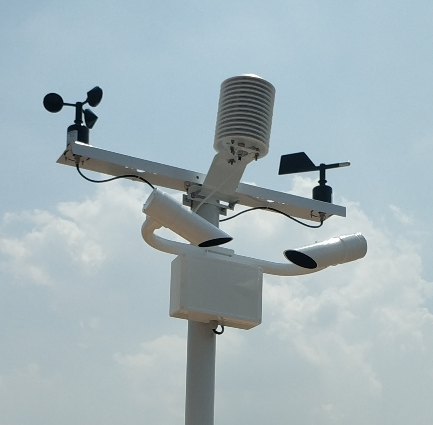Introduction
Automatic Weather Stations (AWS) are important tools for gathering real-time weather data. They are used in many fields, such as agriculture, renewable energy, environmental monitoring, and disaster management. The success of an AWS relies on how accurate and reliable its sensors are.
This article explores the different types of sensors in automatic weather stations. It discusses their functions, applications, and why Coda Sensor is a top provider of weather monitoring solutions.

Function: Measures the ambient temperature and relative humidity of the air.
Importance: These parameters are crucial for climate monitoring, agricultural planning, and HVAC (Heating, Ventilation, and Air Conditioning) systems.
Technology Used: Digital temperature sensors often use thermistors or platinum resistance temperature detectors (RTDs), while humidity sensors typically employ capacitive or resistive sensing elements.
Example Use Case: In precision farming, these sensors help optimize greenhouse conditions by regulating temperature and humidity levels.
Function: Measures atmospheric pressure, which is essential for weather prediction.
Importance: Sudden changes in barometric pressure indicate approaching storms or other weather changes.
Technology Used: MEMS (Micro-Electro-Mechanical Systems) pressure sensors offer high accuracy and stability.
Airports use barometric pressure sensors. These sensors help get accurate altimeter readings. They also aid in weather forecasting. This is important for safe aviation operations.
Function: Measures the speed and direction of wind.
Importance: These sensors are crucial for meteorology, aviation, and renewable energy sectors.
Technology Used:
Cup anemometers or ultrasonic anemometers for wind speed.
Wind vanes or ultrasonic sensors for wind direction.
Example Use Case: Wind farms use these sensors to find the best spots for wind turbines. This helps them generate more power.
Function: Measures the amount and intensity of precipitation.
Importance: Used in hydrology, flood forecasting, and water resource management.
Technology Used:
Tipping bucket rain gauges measure rainfall based on a mechanical tipping mechanism.
Optical rain sensors use infrared beams to detect raindrop intensity.
Example Use Case: In smart city infrastructure, rain gauges help monitor urban flooding. They work with drainage systems to prevent problems.
Function: Measures the amount of solar energy reaching the Earth's surface.
Importance: Crucial for solar power plants, agricultural research, and climate modeling.
Technology Used:
Pyranometers measure global solar radiation.
Pyrheliometers measure sunlight that comes directly from the sun.
Example Use Case: Solar farms use radiation sensors to monitor efficiency and optimize photovoltaic (PV) panel placement.
Function: Measure soil conditions, including moisture, temperature, and nutrient levels.
Importance: Essential for agriculture, forestry, and ecological studies.
Technology Used:
Capacitive soil moisture sensors check how well soil can hold moisture.
Resistive sensors check how well soil conducts electricity.
Example Use Case: Smart irrigation systems use soil moisture sensors to optimize water usage and prevent overwatering.

AWS offers real-time weather data for forecasting and climate research. National weather agencies use AWS sensors to monitor temperature, humidity, wind, and rainfall. This helps improve weather prediction models.
Farmers use AWS to check the weather. They also use it to make irrigation, fertilization, and pest control better. For example, soil moisture sensors with AWS help find the right amount of water for crops. This leads to better yields and uses resources more efficiently.
Wind energy: Wind speed and direction sensors help wind farms assess potential locations for turbine installation and monitor performance.
Solar energy: Solar radiation sensors help solar power plants check how well panels work. They also adjust solar tracking systems to produce the most energy.
Flood prediction: Rain gauges and soil moisture sensors help predict flood risks and improve emergency response times.
Storm and hurricane monitoring: Wind speed, pressure, and humidity sensors give important information for tracking storms and planning evacuations.
Governments and environmental agencies use AWS sensors to track precipitation levels, manage reservoirs, and optimize irrigation strategies.
AWS sensors help in monitoring air quality, noise pollution, and urban heat island effects. Data from AWS can be integrated into smart city platforms to optimize energy use and improve urban living conditions.
Coda Sensor is a trusted provider of high-precision weather monitoring sensors designed for accuracy, durability, and versatility. Here’s why Coda Sensor stands out:
Coda Sensor’s products are manufactured with advanced technology to ensure high-precision measurements, even in extreme environmental conditions.
Coda Sensor provides a full range of AWS sensors. These include sensors for temperature, humidity, wind speed, wind direction, barometric pressure, rainfall, and solar radiation. These sensors are designed for seamless integration into various weather monitoring systems.
Coda Sensor knows that different industries have unique needs. They offer custom sensor solutions. These solutions can work with existing AWS setups or be made for specific uses.
Coda Sensor’s devices are built to withstand harsh environments, including extreme temperatures, high humidity, and strong winds, ensuring reliable performance in challenging conditions.
Coda Sensor offers cost-effective solutions without compromising on quality. With global distribution and technical support, clients can rely on timely assistance and professional service.
Discover how real-time weather station data impr
Discover how Automatic Weather Stations (AWS) ar
Discover how CODA gas sensors are the invisible
Contact: Molly
Phone: +86-17775769236
Tel: 86-0731-85117089
Email: molly@codasensor.com
Add: Building S5, Aux Square, Yuelu District, Changsha City, Hunan Province, China
We chat